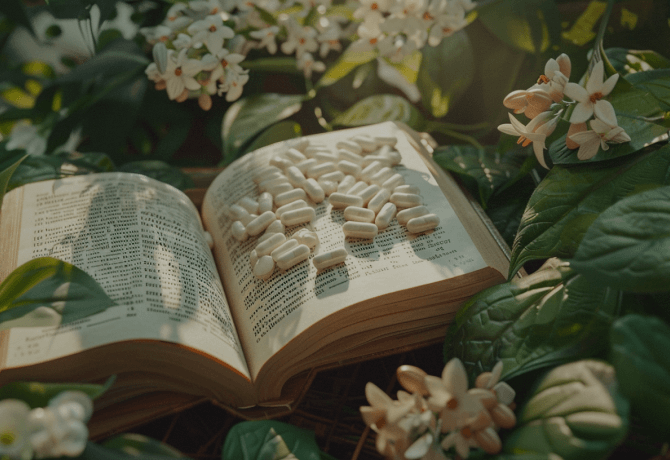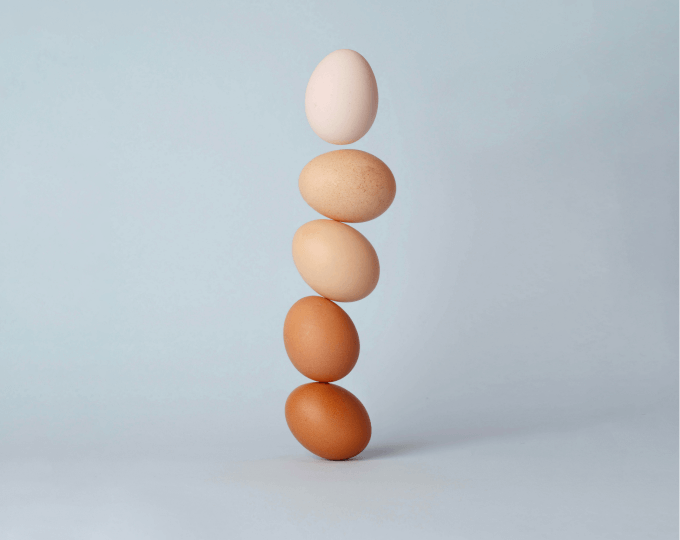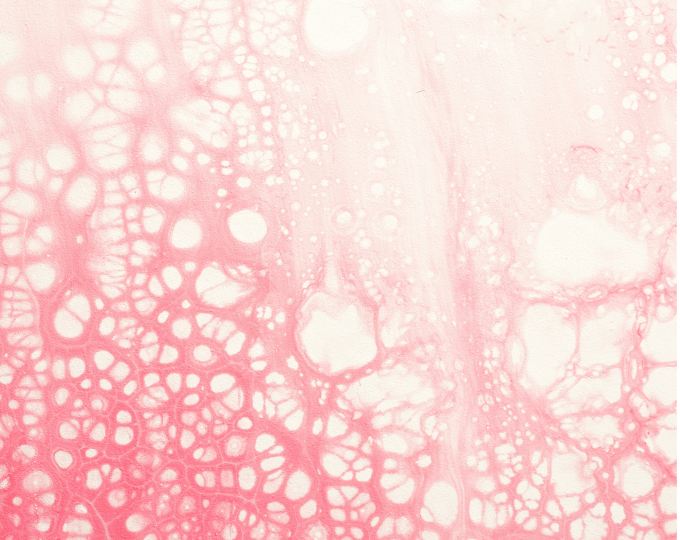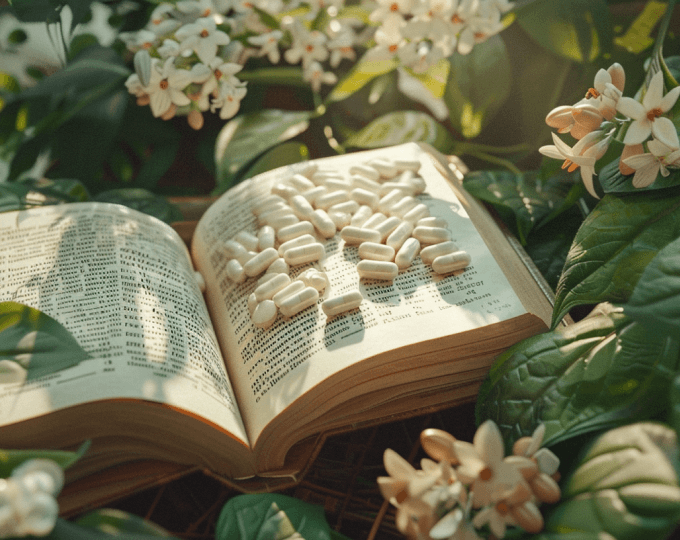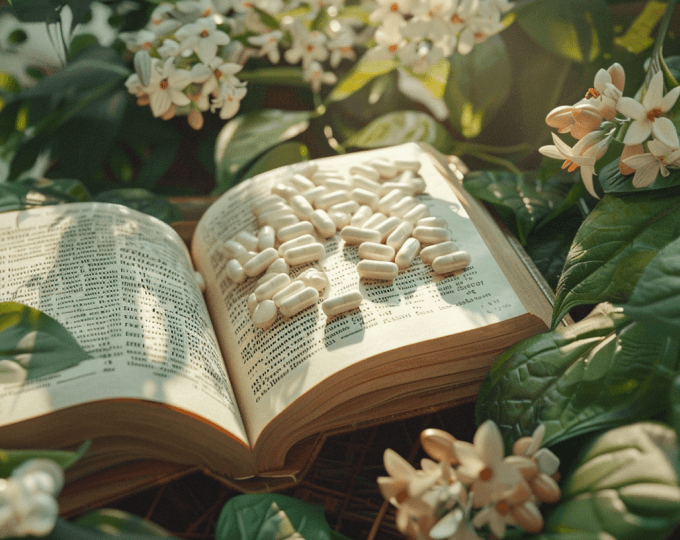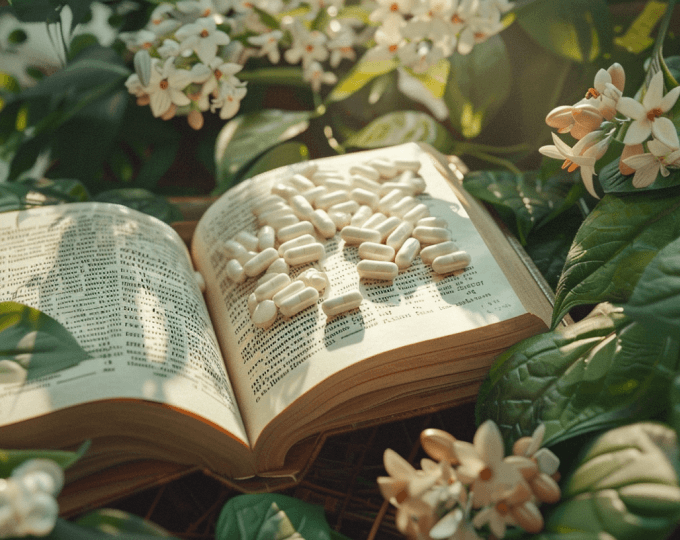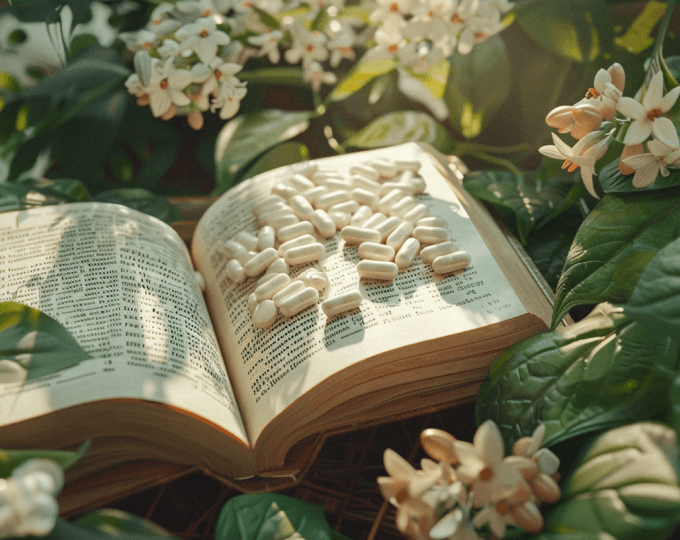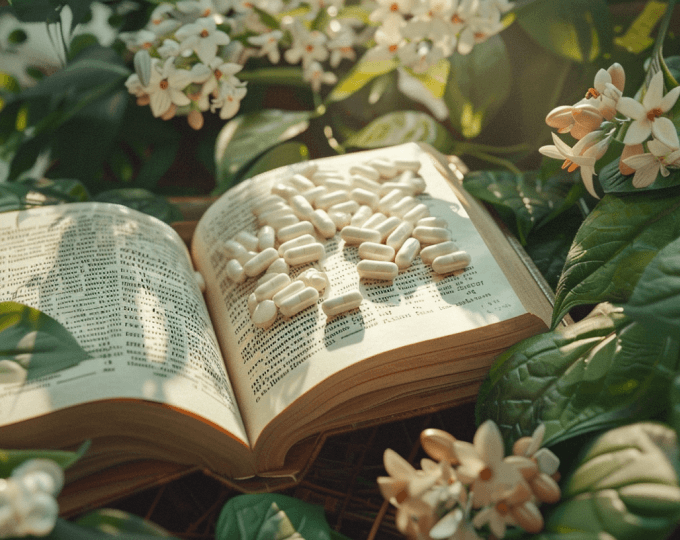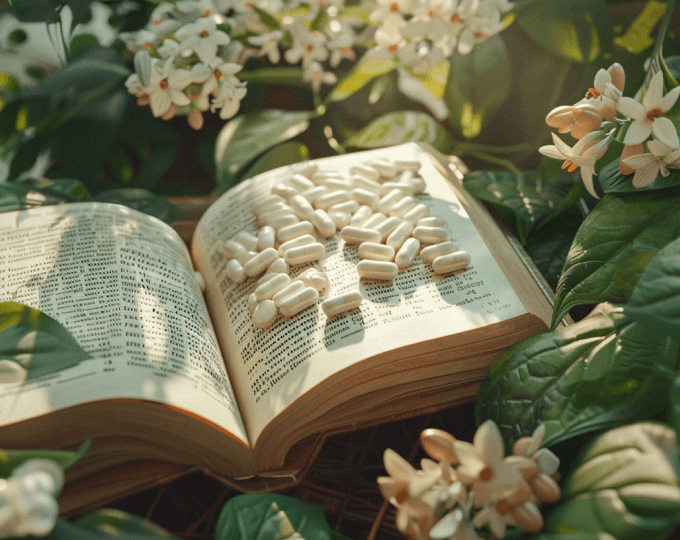Themen dieses Blogartikels:
Table of contents
- Definition: What is Angelica Sinensis Extract (Dong Quai)?
- What are the functions of Angelica Sinensis extract?
- What makes Angelica Sinensis extract unique?
- When do you especially need Angelica Sinensis extract?
- What should one pay attention to when taking Angelica Sinensis extract?
- Which foods contain a particularly high amount of Angelica Sinensis extract?
- Sources & Bibliography
Definition: What is Angelica Sinensis Extract?
Angelica sinensis is the Latin name for Chinese angelica. It is a medicinal plant native to China. It grows as a perennial herbaceous plant at altitudes of 2500 to 3000 meters. Its native habitat is in the cool, humid highlands of central and western China, in the provinces of Sichuan, Gansu, Hubei, Shanxi and Yunnan.¹
The Chinese angelica root has a purplish-green striped stem, light green leaves, and greenish-white, double umbel flowers. However, only the fleshy rhizome is medically significant; it has been valued in Traditional Chinese Medicine (TCM) for millennia. The aromatic root is harvested in late autumn and dried by smoking.² It has a slightly bittersweet, pungent taste and is processed into a strengthening tonic.
What does the name Dong Quai mean?
Incidentally, the Chinese name of the traditional medicinal plant is Dang gui or Dong Quai, which translates as "state of return". This designation indicates the strong healing effect attributed to the plant in Far Eastern medicine. Furthermore, the names "Chinese angelica" and "female ginseng" are common for this plant. The latter alludes to the significant role the herb plays in Traditional Chinese Medicine for women's health.³
The roots of the Chinese angelica were already mentioned in the oldest Chinese herbal book, the "Shennong Bencaojing", which is said to have been written thousands of years ago. Through the Jesuit missionary and sinologist Jean-Baptiste Du Halde, the plant finally reached Europe in the 18th century, where the Angelica Sinensis extract has since become increasingly popular as a "women's herb".
What are the functions of Angelica Sinensis extract?
The root of the Chinese angelica contains many valuable plant substances, including vitamin E, vitamin B7 and vitamin B9, as well as various bitter substances and tannins.⁴
The ancient herbal medicine book "Shennong Bencaojing" lists the most important effect as "harmonizing the blood". Dong Quai has long been valued in China as a remedy for women's ailments, said to stimulate the uterus, regulate menstruation, and increase fertility.⁵
The knowledge about its health-promoting effects comes from folk medicine traditions, and is therefore not always sufficiently scientifically proven. Nevertheless, various studies have already dealt with this special medicinal plant and have discovered amazing things.
Initial study results on Dong-Quai extract
Animal studies with female rats have shown that the plant compounds in Angelica Sinensis extract can have a similar effect to the body's own estrogen. This raises the hope that the root extract could alleviate menopausal symptoms in women.⁶
Another study demonstrated a significant reduction in hot flashes during menopause through the natural plant extracts of Angelica sinensis and Matricaria chamomilla (German chamomile).⁷
What makes Angelica Sinensis extract unique?
The root of Angelica sinensis contains so-called phytoestrogens. These are secondary plant substances whose structure resembles the female sex hormone estrogen, which is why they are also called "plant estrogens".
Traditionally used against menstrual disorders.
The phytoestrogens contained in angelica root extract are said to have a hormone-regulating effect: They are supposed to help counteract the hormonal imbalance during menopause and thus alleviate menopausal symptoms.⁸
In addition, many women swear by the antispasmodic and analgesic properties of Angelica Sinensis extract to alleviate menstrual pain, abdominal cramps, and PMS symptoms. Dong Quai is also said to help harmonize the menstrual cycle and improve the health of the uterine lining, which is supposed to increase fertility.⁹
Other areas of application from TCM
In addition, Chinese angelica is used in Traditional Chinese Medicine to stimulate circulation, strengthen digestion, and treat boils and abscesses.¹⁰
In Chinese herbal medicine, this versatile medicinal plant is also used for rheumatic joint complaints. A scientific study has already found indications that the ingredients of Angelica sinensis could actually work against osteoarthritis.¹¹
When do you especially need Angelica Sinensis extract?
If you are plagued by menstrual problems and menopausal symptoms such as cramps, migraines, mood swings, night sweats and/or hot flashes, the proven medicinal plant Angelica sinensis can offer you natural support.
In Traditional Chinese Medicine (TCM), Dong Quai is primarily used in women's health and is said to help stimulate the production of the hormone estrogen. This is supposed to regulate the menstrual cycle, which could help you get pregnant.
In Traditional Chinese Medicine (TCM), Dong Quai is also used in the treatment of postpartum women: This strengthening tonic is intended to help women recover from the stresses of pregnancy and childbirth.¹² The root extract is attributed with stress-reducing properties that are said to promote relaxation and well-being.¹³
Advertisement
Specifically developed for women's health & the hormone system.
With the premium natural ingredients Dong Quai (Angelica Sinensis), Ashwagandha, Green Tea Extract (EGCG) & Astaxanthin
Supplemented with Vitamin B6 & Pantothenic Acid for hormone regulation.
Without fillers or flavorings
Developed with doctors & experts
Delicious taste & easy-to-dose liquid product

What should one pay attention to when taking Angelica Sinensis extract?
During pregnancy, you should avoid tea or capsules containing Dong Quai: As the American Pregnancy Association reports, the ingredients of the Chinese medicinal plant stimulate the uterine muscles, which increases the risk of miscarriage.¹⁴
You should also not take dietary supplements containing Dong Quai while breastfeeding, if you have spleen problems, or if you have diarrhea.¹⁵
Furthermore, due to the estrogen-like effect of the phytoestrogens contained in Angelica sinensis preparations, you should avoid them if you have a hormone-sensitive type of cancer such as breast cancer.¹⁶
Which foods contain a particularly high amount of Angelica Sinensis extract?
The dietary supplement Dong-Quai extract is offered as tea, drops, tincture or capsules. Often these are products intended to specifically support women's health by promoting hormonal balance and psychological well-being. For this purpose, the root extract is often combined with other nutrients, including vitamin B6, which contributes to the regulation of hormone activity.
This encyclopedia entry is based on carefully researched sources:
Bibliography & Sources
- chemie.de/lexikon/Docosahexaens%C3%A4ure.html
- ak-omega-3.de/omega-3-fettsaeuren/wo-sind-omega-3-fettsaeuren-enthalten/
- ak-omega-3.de/omega-3-fettsaeuren/wo-sind-omega-3-fettsaeuren-enthalten/
- flexikon.doccheck.com/de/Docosahexaens%C3%A4ure
- klartext-futterrgaenzung.de/wissen/lebensmittel/futterrgaenzmittel/omega3fettsaeurekappen-sinnviele-futterrgaenzung-8585
- pmc.ncbi.nlm.nih.gov/articles/PMC3607063/
- fda.gov/food/hfp-constituent-updates/fda-announces-new-qualified-health-claims-epa-and-dha-omega-3-consumption-and-risk-hypertension-and
- klartext-futterrgaenzung.de/wissen/lebensmittel/futterrgaenzmittel/omega3fettsaeurekappen-sinnviele-futterrgaenzung-8585
- flexikon.doccheck.com/de/Docosahexaens%C3%A4ure
- vitalstoff-lexikon.de/Fettsaeuren/Docosahexaensaeure-DHA/Functions
- vitalstoff-lexikon.de/Fettsaeuren/Docosahexaensaeure-DHA/Functions
- ugb.de/ernaehrungsplan-praevention/omega-3-fettsaeuren-ins-essen/
- wdge.de/science/reference values/fat-essential-fatty acids/
- cardiopraxis.de/omega-3-fettsaeuren-increased-risk-of-atrial-fibrillation-at-high-dosage/
- consumingservice-bayern.de/themen/ernaehrung/omega-3-fettsaeuren-unter-der-lupe-3374
- deutsche-apotheker-zeitung.de/news/artikel/2023/01/04/dha-in-der-schwangerschaft-wofuer-und-wieviel
- vitalstoff-lexikon.de/Fettsaeuren/Docosahexaensaeure-DHA/Risk groups
- imd-berlin.de/fachinformation/diagnostikinformation/fettsaeurestatus-der-erythrocytemembrane
- ak-omega-3.de/omega-3-fettsaeuren/wo-sind-omega-3-fettsaeuren-enthalten/
- vitalstoff-lexikon.de/Fettsaeuren/Docosahexaensaeure-DHA/Risk groups
- klartext-futterrgaenzung.de/wissen/lebensmittel/futterrgaenzmittel/omega3fettsaeurekappen-sinnviele-futterrgaenzung-8585
- bfr.bund.de/cm/343/praeparate-mit-omega-3-fettsaeuren-koennen-bei-herzpatienten-das-risk-fuer-vorhofffibriller-erhoehen.pdf
- klartext-futterrgaenzung.de/wissen/lebensmittel/futterrgaenzmittel/omega3fettsaeurekappen-sinnviele-futterrgaenzung-8585
- aquakulturinfo.de/news/studie-zu-omega-3-fettsaeuren-der-aquakultur
